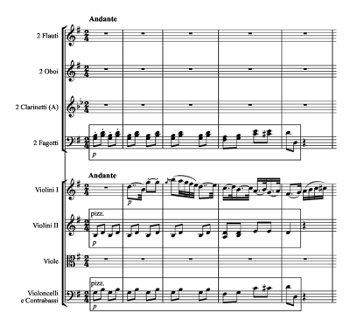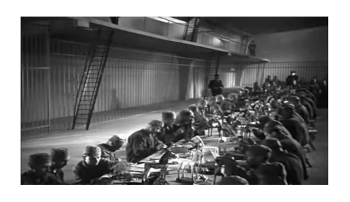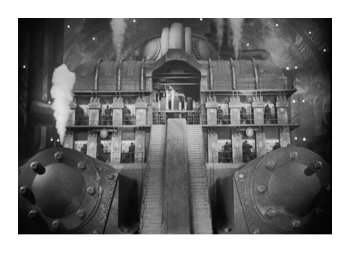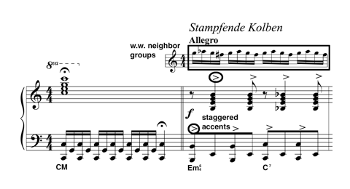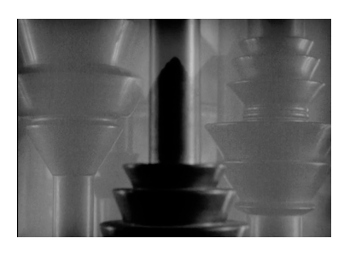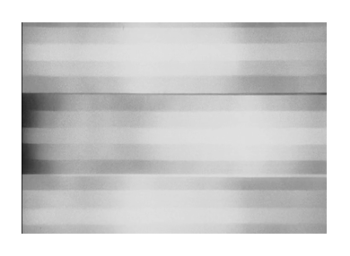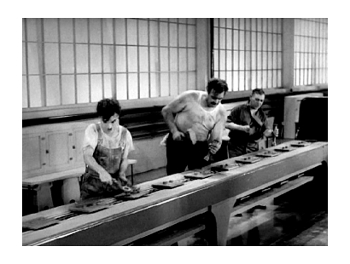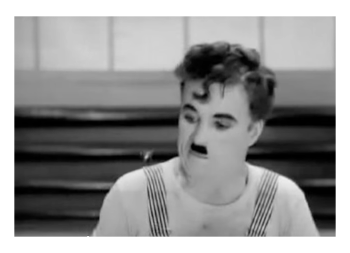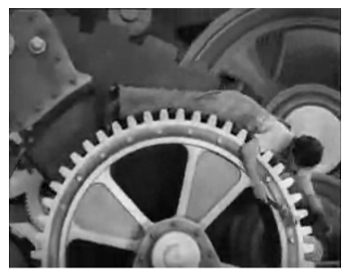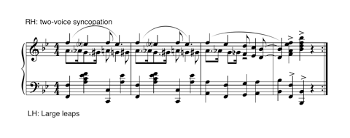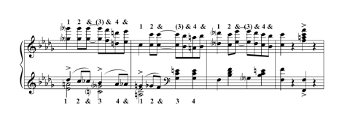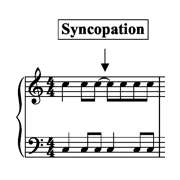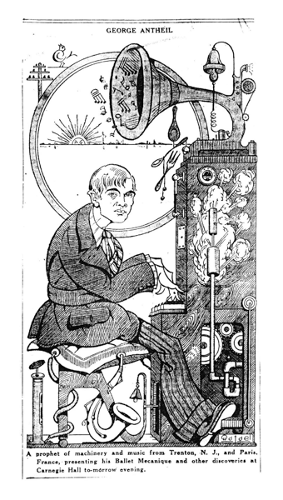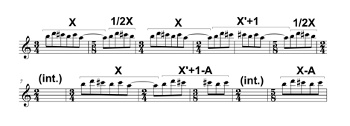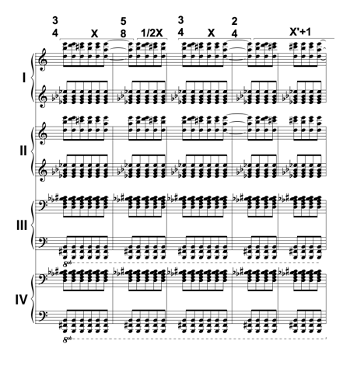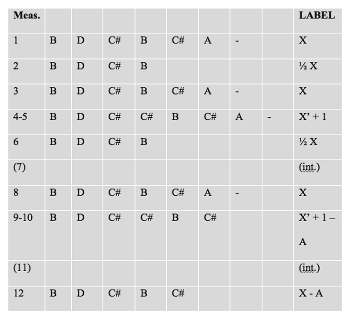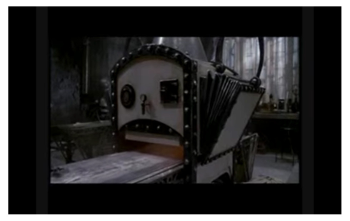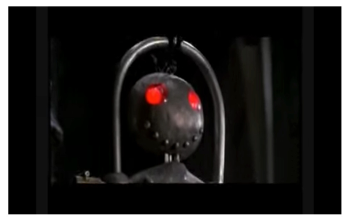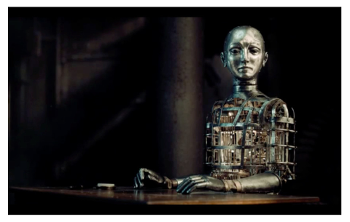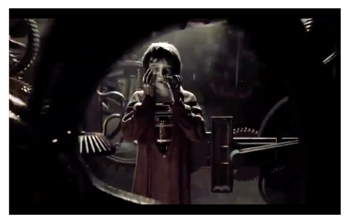Queue the Roll: Taylorized Labor Practices and Music of the Machine Age
Allison Wente
KEYWORDS: Player piano, mechanical music, musical topics, labor, Taylorism, film, Confrey, Antheil, Chaplin, Huppertz, Alarm Will Sound
ABSTRACT: By the early twentieth century the machine aesthetic was a well-established and dominant interest. While this aesthetic has been examined in art and in literature, the representation of industrial labor practices and the role of the machine in musical compositions remain largely unexplored. In this article, I use labor theory to frame a discussion of a musical topic of the mechanical in various musical examples from the United States and Europe in the 1910s, 20s, and 30s. Each example imitates, showcases, or features the sounds of the machine, and illuminates the ways in which industrialized labor influenced music. I organize the machine sounds into three categories: music written to sound like or imitate the machine, music written to highlight the skills of virtuoso performers while also showcasing what the machine can do, and music written specifically for machines. These categories encompass a wide variety of performing bodies, audiences, and spaces, evidencing the ubiquitous presence of the machine aesthetic in early twentieth-century music culture. As the discussion of the examples in each part will show, the prevalence of machine sounds in music indicates the widespread influence of industrialization and its culturally dominant ideology, Frederick Winslow Taylor’s system of scientific management.
DOI: 10.30535/mto.24.4.7
Copyright © 2018 Society for Music Theory
[1.1] The period between the First and Second World Wars earned the title the “machine age,” not only because of the staggering advances in technology and industrial output, but also because of the machine’s symbolic role in modern cultural and aesthetic practices (Wilson 1986, 23).(1) Machines symbolized everything that was modern and new, the latest technology; journalist Alan Trachtenberg (1986) writes, “the machine proposed not only a subject but a means—exact, objective and logical—to cleanse American art of outmoded styles and themes,” and scholar Carol Oja (2000, 61) writes, “during the 1920s, the ‘machine’ came to stand for a staggering array of technological developments.” As film examples from the time show, mechanical sights and sounds shaped the cultural landscape of the 1920s and 30s; more specifically, industrialized labor and relentless mechanical noise forever altered modern musical practices and compositions. Beyond the factory, machines saturated musical culture at various levels and played recorded performances to the eager ears of consumers through phonographs, their quality drastically improved through electrically enhanced recording in 1924 (Kenney 1999, 85). With sales peaking in 1923, player pianos recreated, as if by magic, the keystrokes made by a pianist long after the player vacated the bench, filling parlors, theaters, saloons and roller rinks with the jangling tunes of Zez Confrey or the impressive virtuosic displays of Claude Debussy or Sergei Rachmaninoff (McElhone 2004, 26).(2) Some composers, like George Antheil (and later, Pierre Schaeffer and Edgard Varese, among many others), took the machine and absorbed its sounds, the clinking and clanking of its automatic gears, its rattling engines, its hissing valves and squeaky wheels, and worked them into a concert hall setting in a modern merging of labor and leisure.(3) The sounds of industrialized labor’s regulated and percussive rhythms, frenetic pacing, repetitive nature, and general indifference to metrical hierarchy become features of a kind of musical topic of the mechanical, a topic with various manifestations in diverse contexts.(4)
[1.2] In this article, I identify the emergence of a musical topic of the mechanical in various musical examples from the United States and Europe in the 1910s, 20s, and 30s, each of which first, illuminates the ways in which industrialized labor influenced music and second, imitates, showcases, or features the sounds of the machine. I organize the machine sounds into three categories: music written to sound like or imitate the machine, for which I use examples from film scenes featuring a machine in some way; music written to highlight the skills of virtuoso performers while also showcasing what the machine can do; and finally, music written specifically for machines. These three categories correspond with the three main sections of this article: Part One, The Machine on Screen; Part Two, The Mechanical Novelty; and Part Three, The Mechanical Ballet. The musical examples demonstrate the wide variety of cultural attitudes toward the industrialization of labor. To illustrate music written to sound like or imitate the machine in Part One, The Machine on Screen, I use examples from film to offer a visual depiction of a machine and its music. Each film example aligns the human and the machine—or depicts humans as machines—and the musical accompaniment comments upon the alignment or misalignment of the two. For music written to highlight virtuoso performers and the virtuosic machine, I draw on popular player piano tunes of the time to illustrate the discussion in Part Two, The Mechanical Novelty. And finally, in Part Three, The Mechanical Ballet, I use select pieces from the classical tradition as examples of music written specifically for machines. As the examples discussed in each part will show, the prevalence of machine sounds in music indicates the widespread influence of industrialization and its culturally dominant ideology, Frederick Winslow Taylor’s 1911 system of scientific management, which involves a systematic analysis and breakdown of the labor process into small tasks to be carried out by unskilled or moderately skilled workers.
[1.3] These three categories organize the examples of the musical topic of the mechanical in terms of space. This is not the only way to organize machine music or examples of the musical topic of the mechanical, nor is it meant to be exclusive. But in drawing from disparate musical genres, these examples of “machine music” encompass a wide variety of audiences and spaces, from the movie theater to the domestic parlor and professional stage, and also a wide variety of performing bodies, from the behind-the-scenes film musician to the celebrity virtuoso and established classical performer. Despite their obvious differences in audience, space, and performing body, each example demonstrates a different aspect of the influence of industrialized labor, and a different manifestation of the musical topic of the mechanical. Before I discuss examples of machine music from the machine age, I will highlight a sampling of examples from earlier music—including some from the eighteenth century, a time which Annette Richards (1999, 380) characterizes as “an age obsessed with traveling curiosities, freaks of nature, automata and virtuosos”—that form the basis of the musical topic of the mechanical. These historical examples set the stage for the musical characteristics featured in the twentieth-century examples discussed throughout the three main parts of the article. Finally, the article concludes with a section in which I discuss how these three categories are relevant to today’s musical practices As Taylor’s efficiency-focused reorganization of labor becomes standard, so also does musical culture assimilate machines and their sounds, leading to a blending of machine and musician in the musical labor process.
Prelude: Building the Machine
[2.1] Describing “machine sounds” often brings two situations to mind: one in which the machine malfunctions in some way, spinning out of control, perhaps with blaring alarms and clunking gears that indicate a mechanical failure, and another in which the machine operates smoothly, whirring or ticking without incident. Musically, these sounds manifest themselves in various musical features that form the basis for a musical topic of the mechanical, or even through performers who deliberately imitate the smooth, steady function of a machine. The musical topic of the mechanical emerges in recurring musical elements such as an emphasis on percussion and high-register woodwinds, jagged melodies with dissonant leaps that defy musical convention, excessive repetition or perpetual motion (which often manifests in continually repeated notes or gestures), or, contradictorily, as a stable, regular, minimalist aesthetic akin to a steadily running engine or ticking clock. Moreover, some performers in the late nineteenth- and early twentieth-century deliberately imitated machines in their performances. What follows is an overview of the musical topic of the mechanical in pieces that imitate machines, followed by a brief a discussion of first, a nineteenth-century performer’s imitation of the sewing machine and second, a clock shop musical novelty.(5)
Example 1. Ticking clock in Haydn’s Symphony no. 101 in D major, II, mm. 1–5
(click to enlarge)
[2.2] The musical topic of the mechanical appears and develops in the eighteenth- and nineteenth-century classical tradition, creating a kind of musical foundation of mechanical sounds upon which later examples build. For example, the repetitive eighth notes in the second movement of Haydn’s Symphony no. 101 (1794), shown in Example 1,(6) earned the symphony its nickname “The Clock.”(7) Similarly, in the second movement of Beethoven’s Eighth Symphony (1812), the woodwinds carry constant sixteenth notes that imitate a metronome in a clear demonstration of the musical topic of the mechanical, and the movement ends abruptly without the expected repeat, as if the machine was simply turned off.(8) In addition to musical depictions of the mechanical, well-known composers from as early as the eighteenth century were interested in writing specifically for mechanical instruments as performers. Handel wrote for chimes and carillon, and Haydn and Mozart for flute-playing clock (Fowler 1967, 45).
[2.3] In Leo Delibes’s ballet Coppelia (1870), an inventor creates a life-like mechanical dancing doll who, along with several other mechanical dolls, dances to Musique des Automates. The music features a piccolo melody accompanied by high-register woodwinds, violins, viola, and glockenspiel on repetitive eighth-note figures akin to those in the Haydn and Beethoven works mentioned above. The musical topic of the mechanical appears in Offenbach’s The Tales of Hoffmann (1880) when Olympia, an automaton, performs an aria in which she occasionally stalls out, winds down, and needs to be re-wound in order to continue. Musically, Olympia’s virtuosic melody stalls on
[2.4] While some pieces demand that a performer imitate a machine as part of their role, it was not uncommon for performers and pieces to draw on mechanical sounds to create a sense of spectacle. For example, African-American pianist and composer Thomas Greene Wiggins, better known as “Blind Tom” and called a “human music box” by Willa Cather, was known for incorporating imitations of a sewing machine into his performances (Allen 2015, 44–45) .(10) He went so far as to compose “Sewing Song (Imitation of a Sewing Machine)” (1886) which, after a fantasia-like opening, maintains a steady stream of sixteenth notes in the right hand. The piece has a pastoral affect and, despite the piece’s title, gives no indication that the sixteenth notes should remain obsessively regular or mechanistic. Using sixteenth notes to mark the sewing machine is not without precedent; indeed, steady sixteenth notes in the right hand indicate the spinning wheel in Schubert’s “Gretchen am Spinnrade” (1814). Wiggins’ interpretation of the sewing machine is loose when compared to the mapping of the wheel, bobbin, and pedal of Gretchen’s perpetually spinning wheel, which is more similar to the direct imitation found in novelty pieces.(11)
[2.5] Some early musical novelty pieces (often borrowed from band repertory) are more literal in their incorporation of mechanical sounds into an amusing collection of sound effects (Altman 2004, 383). Through sound effects, pieces like Charles Orth’s “In the Clock Store” (1893), M. L. Lake’s “In a Bird Store” (1916), Moses Tobani’s “Trip to Coney Island” (1899), or J. Bodewalt Lampe’s “Fun in a Music Store” (1921) were meant to musically illustrate the sound effects of each place. Unsurprisingly, “In the Clock Store” provides a particularly mechanical example of a musical novelty piece.(12) Rick Altman’s (2004, 383) summary of “In the Clock Store” is particularly vivid: “After the apprentice opens the store and winds up the clocks we hear the clock sticking, the cuckoo clock striking the hour, an alarm clock ringing, the apprentice whistling a tune, a clock with chimes running down, the same clock after rewinding, and Scotch Cathedral Chimes in the distance.”(13) Decades later, ensembles would play these novelty pieces to fill the silence between films.(14) Through its musical depiction of an alarm clock, cuckoo clock, and the musical marking of mechanical changes like the rewinding of a clock’s gears, the mechanical sounds in “In a Clock Store” serve as an example of the musical topic of the mechanical just before the machine age.
[2.6] In the twentieth century, when the figure of the machine itself attained a new level of cultural power, certain mechanical sounds such as high-register woodwinds, over-emphasized percussion, and excessive repetition became more prevalent as a musical topic of the mechanical. With the development of recording technologies and vastly improved mechanical instruments, moreover, composers who wanted to represent machines musically could draw on the resources of these musical machines, as well as already-established musical conventions from the classical era. Consequently, they could double the mechanical aspects of music by presenting the mechanical musical topic as played by a machine. Of course all musical instruments are machines, just as any object that produces sound can technically be considered a musical instrument. In order to provide some boundaries for this article, however, I define musical machines as devices that carry out musical labor or humans acting as machines while also creating music. Beyond those limitations, I deliberately define “machine” broadly, suggesting that it underpins musical representations of clocks and automatons; music may imitate the machine, like Haydn’s clock or the chiming and ticking of “In a Clock Store”; music can represent a machine’s movements, as in Coppelia’s dance or Olympia’s aria; or music may be written specifically for machines, like in works for flute-playing clock or player piano. When grouped together, these distinct musical representations of machines create an overall musical topic of the mechanical, a topic that experiences an industrial-sized resurgence in the machine age.
Part One: The Machine on Screen
[3.1] For examples of music written to sound like or imitate the machine, my first category, I will use particular scenes from three films: Metropolis (1927), À nous la Liberté (1931), and Modern Times (1936) .(15) Michel Chion (2003, 41) connected these three films and the machines they depict when he wrote, “machines are good when they serve to build a better world
[3.2] In his 1911 monograph, Taylor, an American mechanical engineer and pioneer in the efficiency movement, proposed a labor theory that privileged measurable efficiency and productivity that was important to the reorganization of industrial work in the first part of the twentieth century. For Taylor, the end-result, production, took precedent over creating a rewarding labor process for the worker. He therefore favored designing work for unskilled, unthinking labor—labor organized so that “an intelligent gorilla” could accomplish it (Taylor 1911, 40). In imagining labor as subhuman work, scientific management stripped workers of their subjectivity, and so also of their humanity, re-rationalizing labor as the work of objective bodies of pure drive, mindless and faceless, trained to mimic to the letter the machines that would replace them. This rationalization followed a two-step process. First, the production process deskilled labor, desubjectivized individuals, and melded them into a mechanized collective body of laborers whose de-emphasized humanity categorized them as neither human nor machine. These laborers exemplified Taylor’s “intelligent gorillas,” useful only in so far as they could mimic and repeat the same task ad infinitum. Second, the production process modeled this collective body on the machine, and it did so in such a way that as technology improved, eventually an actual machine could replace the collective.
[3.3] The industrialization of labor radically transformed society, and as Michael Hardt (1999, 91) writes, “society itself was gradually industrialized even to the point of transforming human relations and human nature. Society became a factory.” The gruesome picture presented in Metropolis and the assembly lines of À nous la Liberté and Modern Times reflect and comment upon Taylor’s labor process, warning of the dangers of idealizing unskilled labor. These three films highlight the representation of mechanized labor, the first in worker’s repetitive and seemingly meaningless monitoring of the machines, and the second and third in the similarly repetitive and particular labor on the assembly line. The two labors are of the same kind, as both demand first that a worker repeat the same task again and again for an assigned number of hours, and second that the work ends when the clock marks the ending of a shift, not with the completion of a particular product or task. The combined labor of multiple bodies increases production as time-based work seemingly presents a mechanized living body as the perfect worker.(16) As Richard Guy Wilson explains, “even human beings were viewed as machines in the scientific management and time-motion studies of Frederick Taylor and his disciples” (1986, 25). These films present human laborers and machines as almost inextricable, blurring the boundaries of where the human ends and the machine begins.
Example 2. Toy horse assembly line in À nous la Liberté’s French prison
(click to enlarge)
Example 3. The prisoners’ melody, À nous la Liberté (transcribed by author)
(click to enlarge)
[3.4] Clair’s À nous la Liberté, scored by Les Six member Georges Auric, follows two cellmates first as they labor over toy horses on an assembly line, shown in Example 2, and later as they make their separate ways outside of prison (Donnellon 2006, 13). That the men work on an assembly line is important: together they create the laboring machine, and together they embody Taylorized labor principles. The prisoners sing as they work, which in a sense humanizes the soundtrack; the music comes from the men, not their labor. Although the music sets the tempo for their labor, its lyrics comment on their imprisoned status. The men sing “La liberté, c’est pour les heureux (Freedom is for the fortunate),” and “Ah!
[3.5] The prison assembly line operates on a pre- or early industrial model based on hand-held tools and human labor rather than on a literal machine made of metal and gears. Instead, the prisoners are the nuts and bolts of the machine while the non-diegetic simple flute melodies (motivic ideas taken from the melody shown in Example 3) punctuated by occasional snare drum hits serve as a kind of childish military band accompaniment, commenting on the simplistic nature of the prisoners’ work.(17) The music in À nous la Liberté, music written to sound like or imitate the machine, provides the least obvious example of my first category of machine music. À nous la Liberté depicts prisoners who are already considered subhuman by most of society as Taylor’s “intelligent gorillas.” And their music—like their labor—is simple, lacking much of the mechanistic virtuosity and rhythmic complexity of other examples.
Example 4. The “line workers” of Metropolis
(click to enlarge)
[3.6] Though the overly simple tasks assigned to prisoners in À nous la Liberté are similar to those of the laborers in Metropolis, their musical and mechanical setting is quite different. Example 4 shows the “line workers” of Metropolis, monitoring the advanced gauges of a huge machine. Gottfried Huppertz, a German composer and actor, scored Fritz Lang’s futuristic science fiction film called, in its own time, “a vision of the machine age” (Needham 1928, 46) .(18) The film focuses on class divisions, which have become so extreme that classes are separated into physical levels with the highest classes above ground and the workers below.(19) The film partitions the body into head, intelligent but detached managerial labor, and hand, unintelligent and dull line laborers, and thus critiques modern labor practices for excluding the heart, whose essential rhythmic beating drives the body. The film maps the division of labor and consequently class division allegorically onto the parts of the body. The situation becomes so dire as to require a mediator, the heart, in order to keep the head and hand from separating completely.(20)
Example 5. Allegro, Stampfende Kolben, Metropolis
(click to enlarge)
[3.7] Metropolis depicts a dystopic view of the modern industrial age, beginning with its opening scene. After the title sequence, the screen fades and, as shown in Example 5,(21) the music quickly shifts to an allegro marked by a spinning chromatic flurry in the upper woodwinds (0:50). The trumpets, brass, and strings pound out minor harmonies on the upbeats, creating a sharp contrast against the heroic and stable melody and major key of the title sequence. Stomping pistons (“Stampfende Kolben”), shown in Example 6, appear on the screen as the beginning of a montage sequence. The restless pumping of the pistons comes through musically in the offbeat accents and incessant chromatic cycling of woodwind neighbor groups. The steady eighth note bass, which seemed comfortable in the title sequence, now adds to the edgy and uneasy quality of this section—it is at odds with the offbeat accented harmonies, and the two essentially create constant accents at the eighth note level. The screen shows a close-up shot of the pistons as they move up and down, out of sync (in the Kino DVD print) with the accented offbeat eighth-note harmonies.(22) The misalignment between music and machine inadvertently features the odd circumstances surrounding music written to sound like a machine. Undoubtedly the pistons shown on screen have a particular sound, and yet the music, with its high woodwinds and blaring horns, departs from that sound and instead creates a musical version of a generalized “mechanical” sound. The regularity of the offbeat accents, the nervously fluttering woodwinds, and the blaring horns each take certain aspects of the mechanical—its regularity and relentlessness, its unpredictability and insensitivity to musical expectations—and apply them to more familiar musical circumstances. The music does not directly map the noise of the machine onto the score; rather, the music picks and chooses certain features of mechanical sound and applies them to create a musical representation of the machine.
Example 6. Stomping Pistons (“Stampfende Kolben”), Metropolis (click to enlarge) | Example 7. Stomping Pistons (“Vertikale Lichtstreifen”), Metropolis (click to enlarge) |
Example 8a. Vertikale Lichtstreifen, Metropolis
(click to enlarge)
Example 8b. Jagged, dissonant melodic line; Metropolis
(click to enlarge)
[3.8] The three vertical pumping pistons fade into three horizontal strips of light (“Vertikale Lichtstreifen”) (0:54), shown in Example 7, that soon reveal a large spinning wheel (0:57). Example 8a shows the full accompaniment for the strips of light. Shown in Example 8b, a jagged whole-tone melody enters, machine-like in its indifference to standard melodic resolutions and practices and featuring the leap of a minor seventh. When stacked, the pitches used in the trumpet’s melody here create a polytonal effect, juxtaposing a perfect fifth based on A against an
Example 9. Chaplin as an assembly line worker in Modern Times
(click to enlarge)
[3.9] At times multiple images layer and blur the edges of the mechanism and the pieces appear as independent machines. Each piece tirelessly labors on screen, and yet the film never shows a finished product, setting the tone for the workers’ feelings of futility. The combined labor of the mass of relatively unskilled workers keeps the machine running. The group of workers embodies the heart of the machine, because they keep it pumping. Meanwhile, the system devalues the individual skilled laborer and increases productivity. The workers themselves are like the disjointed pieces of the machine at the film’s opening, isolated from the end result and from each other, toiling for a product to which they will never connect.
[3.10] Whereas Metropolis paints a bleak picture of industrial society with unhappy workers and blatant class divisions, Modern Times uses humor to make a similar statement. Influenced by À nous la Liberté, Chaplin’s Modern Times tells of a faulty factory worker, shown in Example 9, who falls behind on his assembly line duties after encountering a series of distractions.(23) The comedy that ensues is pure humanity in its flubs and flaws; the film uses humor to show the ridiculousness of forcing a human to work as if he were a machine. The mechanistic labor highlights the inadequacies of humans, which comedy then highlights further through the particular absurdities of Chaplin’s tramp. Chaplin composed much of the score for Modern Times himself, but as he did not possess the musical knowledge to compose a full score, he worked extensively with David Raksin (Lynn 1997, 383).(24) The music from Metropolis’s opening scene, along with that of Modern Times’s assembly line scene, illustrate how the mechanical aspects of the music imitate the machines shown on screen, often creating dissonance against the movements of their human operators.
Example 10. Chaplin and the Bee, Modern Times
(click to enlarge)
Example 11. The distracting bee, Modern Times (transcribed by author)
(click to enlarge)
[3.11] The first assembly line scene begins with playful strings and twinkling upper woodwinds accompanied by the image of workers hammering away on the line. Chaplin turns screw after screw, but when he pauses briefly to scratch an itch, the line backs up and the music shifts into minor. Chaplin and his supervisor argue.(25) Chaplin gets back to work, only to have a bee, shown in Example 10 and marked aurally by a series of ascending triad arpeggiations in the flute shown in Example 11, fly around his head.
[3.12] The president of the company comes over the speaker and pushes for more speed just as Chaplin is relieved from his spot on the line (4:42). He walks away to the same music that played earlier, the music of the assembly line. Even though he is not actively working on the line, his body still jerks through the motions of his labor, turning screws in the air as his legs awkwardly try to walk (5:06). Garrett Stewart (1976, 297) describes these laboring aftershocks as symptoms of the “internalization of mechanical rhythm” and writes that the rhythm “attacks Charlie and pushes him over the edge early in Modern Times; for him there is no stoppage of the machinery in his own nervous brain as he careens wildly about the factory in an involuntary hysteria of bolt-tightening gestures long after he has been yanked from the conveyor belt.” That the music follows Chaplin rather than the machine reveals that while the music scores the machine in Modern Times, the “machine” is not the monstrous mass of metal and screws but rather the labor process—Chaplin, and at times the other workers, repeating the same tasks mindlessly, mechanically, and monotonously.
Example 12. Chromatic sequence, Strings, Modern Times (transcribed by author)
(click to enlarge)
Example 13. Chaplin in the machine, Modern Times
(click to enlarge)
[3.13] Later in the film we see Chaplin working his afternoon shift. He quickly falls behind and when his supervisor yells at him, the strings undulate through a five-note chromatic sequence that gradually ascends by half step (14:13), shown in Example 12. When his supervisor leaves, the strings begin constant arpeggiations over harp glissandi until he falls so far behind that the strings repeatedly glissando. Mallets mark the beat with repeated quarter notes, gradually ascending higher and higher as Chaplin loses control (14:23). Chaplin climbs onto the line to try to regain his place, but instead he moves towards the mouth of the machine. His neighbor catches his feet, but with a loud cymbal crash, Chaplin enters the chute at the end of the conveyor belt and winds through the gears (14:45). The music stops as the cymbal crash resounds. Example 13 shows Chaplin trapped in the gears, tightening stray bolts as he goes, while the woodwinds and glockenspiel bumble through an out-of-tune off-kilter waltz. Chaplin’s supervisor unwinds the machine and the music changes character again, moving through another ascending chromatic line as Chaplin untangles from the machine’s innards and re-enters the workroom with a piccolo trill and flourish (15:11).
[3.14] The “machine” music of Metropolis and Modern Times uses woodwinds and percussion centered themes, constant driving rhythms, and odd rhythmic accentuations to mark the mechanical aspects of the music. The prisoners sing the lilting melody of À nous la Liberté, on the other hand, as if to suggest that the human voices have become part of the assembly line and that the human laborers are the machine. Metropolis’s music maps directly onto images of the machine and the music conveys the mechanical within the context of a more traditional score. Rather than directly imitating the sounds of the machine, Metropolis’s score presents a mechanized musical version of those sounds—music imagined as machine. The score for Chaplin’s Modern Times is similar to that of Metropolis: the music accompanying the assembly line scenes is distinctly mechanical, with quick, regular rhythms and woodwinds and percussion to highlight the machine’s literal presence and its role in the action on screen.
[3.15] All three scores perform mechanical sounds through a musical setting, using music that sounds like or imitates the machine. The difference between them lies in the mechanism that each score imitates. À nous la Liberté imitates the machine on screen, but the laboring prisoners metaphorically embody the machine. In Metropolis the mapping is more direct, as the screen clearly shows each machine that the music imitates; when the machine image changes, the music changes as well. However, in Modern Times, the music correlates more directly to Chaplin’s movements—which certainly clash with the mechanistic movements he should be carrying out —rather than the movements of the machine. But if the assembly line, and the Taylorized breakdown of the labor process, turns a group of workers into a collective body of labor, wherein the most valuable laborers are those who blend best into their work, then the actual machine in Modern Times is the collective body of workers, much like in À nous la Liberté. Chaplin’s “individuality”—his humanity—makes it difficult for him to assimilate into this body, and the music illustrates his distractions and flaws as an assembly line worker by accompanying the distracting bee or his itchy nose. In other words, the music strays from the musical topic of the mechanical when Chaplin’s attention strays from his work. Chaplin’s incessant tightening of gears aligns with the incessant ringing of mallet and woodwind instruments in his score, a score for the human machine.
[3.16] These film examples present three different versions of the mechanization of human labor. Metropolis presents the human laborers as mindless puppets, and its music demonstrates the clearest example of the musical topic of the mechanical. Modern Times acts as a kind of bridge between Metropolis and À nous la Liberté in that it openly presents the struggle of a human trying to labor as a machine, and its music reflects that struggle between the musical topic of the mechanical and a distracted narration of Chaplin’s wandering attention. And finally, in À nous la Liberté, the prison laborers provide the soundtrack for their work, as if the mechanized labor has claimed the most human part of them, their voices. In suggesting that the human workers and their collective labor form part or all of the machine, Taylorised labor celebrates a kind of labor that absents humanity. Production takes precedence, labor is subhuman, and the ideal worker is a mindless, faceless body. In foregrounding the dangers of mechanized labor, whether through Modern Times’ comedic setting or the darker scenes of the factory and prison of Metropolis and À nous la Liberté, these films and their scores reflect machines’ encroaching influence over labor during the machine age.
Part II: The Mechanical Novelty
[4.1] In addition to providing musical accompaniment for silent films in early motion picture houses, the player piano (a blanket term I will use to refer to various models of self-playing mechanical piano) brought mechanized music into saloons, theaters, and parlors. I use the player piano to exemplify my second category, music written to highlight the skills of virtuoso performers while also showcasing the machine, because it delivered physical evidence of a player’s technique through the visual display put on by the piano’s keys in a way the phonograph record and radio could not.(26) In addition, as David Suisman (2010, 13–14) argues, at the turn of the century “many more people saw the player-piano as a revolutionary cultural force and the phonograph as a mere trifle than the other way around.” Player pianos could work longer hours and perform with fewer errors than a live musician, and paper piano rolls cost less than several hours’ wages. The presence of ragtime in saloons at the turn of the century, in particular, helped smooth the transition from live pianist to player piano. Because most ragtime composers wrote specifically for the piano, the music especially suited the player piano and thus the instrument became a kind of showcase for the talents of ragtime composers.(27) In addition to ragtime’s popular music sales, the reproducing piano’s (a more sophisticated kind of player piano, meant to capture the interpretation of the player) of recording duplication of recorded performances by famous pianists and composers such as Claude Debussy, Sergei Rachmaninoff, Ignace Jan Paderewski, and George Gershwin, created a market for the wealth to own and replay concert-level performances in their own homes (Chanan 1999, 60). Rolls of ragtime music and famous performers took advantage of the player piano’s mechanical performances, then, in a few ways: in selling music written specifically for player piano, in selling specific performances, and in showcasing the technical capabilities of the machine itself.
Example 14. Challenging rhythms and doublings in Bargy’s “Jim Jams”
(click to enlarge)
[4.2] The piano roll drew attention to the piece and more importantly to the (absent) pianist, the celebrity composer/performer whose ghostly fingers tickled the ivories from coast to coast. As examples of popular works written specifically for player piano, I focus on novelty rags, a primarily post-World War I subsection of the ragtime genre involving triplets, syncopation, and parallel fourths (Banfield 2004, 98) .(28) Several U.S composers wrote works in the novelty rag genre, including Roy Bargy with “Jim Jams” (1922), shown in Example 14, which includes rhythmically and technically challenging interruptions, and “Pianoflage” (1922), a work that is a lengthy 126 measures (not including repeats!) of near-nonstop syncopated quarter and eighth notes. George Linus Cobb’s “Snuggle-Pup” (1929) pairs a boom-chuck left-hand pattern (similar to the pattern shown in “Jim Jams”) and a relatively simple melody for the genre. Finally, Zez Confrey was specifically known for his novelty rags, and his works like “Kitten on the Keys” and “Poor Buttermilk” epitomize the genre with an emphasis on speed and technique that usually proved too difficult for the amateur pianist.(29) His technically and rhythmically challenging novelty piano pieces appealed more broadly as piano rolls than as sheet music, and as such they exemplify a key kind of mechanical music.
Example 15. “Kitten on the Keys,” Trio, mm. 64–70
(click to enlarge)
[4.3] The score for “Kitten on the Keys” conveys not only several complexities that would have intimidated many amateur pianists, but also the more “mechanistic” features of the work. The piece has three sections, much like a traditional rag. Its trio section, the beginning of which is shown in Example 15, hammers at a relentless fortissimo (boxed in the example) with accents on almost every attack, including the blaring octaves in the left hand. The relentless accents bring to mind the staggered accents of Metropolis (Example 5), wherein the constant accents cancel one another out. In “Kitten on the Keys,” as in Metropolis, the accents imply an indifference to metrical hierarchy and beat patterns in an aggressive push towards randomness rather than musical coordination. The right hand takes advantage of the full keyboard, reaching G7 (circled in the example) multiple times. At several points the right hand must balance one syncopated rhythm in the top voice while the lower voice carries another syncopated rhythm, all while keeping track of the steady left-hand chords and octaves which often require the left hand to hop between the low and middle ranges of the keyboard.
Example 16. Particularly difficult syncopation in “Kitten on the Keys,” Trio, mm. 95–98
(click to enlarge)
[4.4] Example 16 shows one particularly difficult passage from the end of the trio, mm. 95–98. Negotiating this combination of rhythmic complexity and large range demands a highly skilled pianist, who would likely still be challenged by the piece’s Allegro moderato tempo. These factors increased demand for rolls and records of the piece, and more specifically for Confrey’s performances of the piece on rolls and records. As David Thomas Roberts (2001) writes, “The novelty style was influenced by piano-roll arrangements, and many works demanded considerable pianistic skill; indeed, their composers were among the most adept pianists in the popular field.” In composing difficult works, Confrey essentially created a demand for more than sheet music—Confrey sold his performance along with the piece.
Example 17. Hypermetric Complexity in “Poor Buttermilk”
(click to enlarge)
Example 18. Melodic simplification of m. 24, “Poor Buttermilk”
(click to enlarge)
[4.5] Another Confrey novelty work, “Poor Buttermilk,” has a darker tone than “Kitten on the Keys,” and its B section is arguably the most rhythmically challenging passage of the Novelty rag genre (Jasen and Tichenor 1978, 219). The section begins in
[4.6] These two pieces are just a sampling of Confrey’s ninety novelty rags—a figure that marks him as the “most prolific and versatile writer of piano novelties” (Shaw 1987, 86) .(30) The novelty rag became popular just as recording technology emerged, and recorded music then changed performance practice in the private sphere as well (Jasen and Tichenor 1978, 215). Indeed, from the turn of the century to the mid-1920s, sheet music sales slumped while player piano sales soared.(31) Rather than writing difficult music solely for stage performance, composers like Confrey wrote for piano rolls to showcase their own talents and capitalize on their skills as well; the machine allowed them to record and duplicate their performances as a new type of musical commodity.(32) Concurrently, while Confrey and others composed and consumers adjusted to music as issued from a machine, music became more accessible to more people through the popularity of records and rolls. The popular music market supplied a seemingly unending amount of catchy new tunes, and consumers came to desire the commodity; consuming the latest pop tune became “the path to personal fulfillment” (Suisman 2009, 10).
[4.7] Another performing commodity came in the form of celebrity rolls, of which there are several hundred surviving examples (Philip 1998, 77) .(33) More often than not, these rolls were for the expensive reproducing piano, and as Russell Sanjek (1988, 383) writes, “it became the fashion to invite friends to home concerts by Paderewski, Debussy, Grieg, or Victor Herbert.” Regarding the rolls’ historical value, Ord-Hume (1970, 35) writes: “we may hear from a music-roll the identical performance and interpretation of a pianist long since dead.”(34) Many artists recorded for both roll and record, and the differences between similarly timed recordings demonstrates the player piano’s (and piano roll editor’s) ultimate influence over the resulting musical commodity. For example, Sergei Rachmaninoff made two recordings, one roll and one record, of his C-sharp minor Prelude in 1919.(35) Claude Debussy recorded fourteen pieces for the reproducing piano, but due to flaws in the Welte-Mignon recording system in catching nuanced pianistic shifts of color, his rolls are not highly regarded as a record of his playing. It was odd that Debussy would have recorded on piano roll to begin with, as he was reportedly a pianist “uninterested in velocity or cold clarity per se” (Howat 1997, 102) .(36)
[4.8] That the piano rolls presented perfected versions of some artists’ performances, as in the Rachmaninoff work, or the de-nuanced playing of performers who emphasized pianistic subtlety over technical virtuosity, as in Debussy’s rolls, demonstrates that though these rolls were marketed as accurate recreations of a particular celebrity’s playing, they were instead mechanized performances influenced by—or limited by—the machines that played them. The mechanical virtuosity is different in kind from the musical virtuosity of Rachmaninoff’s playing or the expressive virtuosity of Debussy’s, and it is the mechanical virtuosity that the player piano emphasizes: each roll showcased the machine as much as a particular artist’s rendition.(37) Moreover, the roll reproduced mechanized labor, musical labor reduced to data, duplicated by a team of workers, and reproduced by machine. The machine does not, then, reproduce the virtuoso’s highly skilled musical labor, but rather a concretized version of that labor, distilled, boiled down, and modified to suit the mechanism. The reproducing piano and mechanical reproduction irrevocably redefine virtuosic performance as something that can be reproduced without the live, laboring presence of the virtuoso.(38) The reproducing piano, and the player piano, allegorically demonstrate the influence of Taylorized labor on musical practices, the effects of which still impact the highly edited and technically perfect recordings of today’s market.
[4.9] Yet unlike the invisible labor hiding in a record’s grooves or in the data of an mp3, the player piano, with its uncanny visual display, could not completely erase the visibility of the performer: the moving keys indexed the performer’s absent body.(39) The invisible performer played on command; the instrument conjured a performing specter, a servant to the pianolist. Moreover, the live presence of a pianolist at the bench, operating the instrument and adding musical interpretation to the roll, complicated the notion that the instrument issued a perfect mechanical reproduction of a highly skilled performer.(40) Taking a note from Taylor’s positive spin on de-individualization in the workplace, player piano manufacturers worked hard to convince consumers that they were listening to a piano played by real musicians; one Welte-Mignon advertisement (Anon. 1911, 19) claims “the interpretation is so faithful and characteristic that the artists who have performed for the Welte-Mignon have endorsed each roll with their autograph.” The detachment of music from the laboring performer embodies Taylor’s philosophy of breaking down labor into small easily managed pieces, of blurring the overall production process in the fracturing of its steps so that no one laborer can be credited with a particular creation. At the same time, mechanical reproduction and the player piano foreground the wonders of Taylorized labor, helping to showcase the magic of machines by taking something expressive, musical labor, and Taylorizing it; the musical machine is the spectacle and the pianist (excepting known and marketable virtuosos) joins the line of faceless workers. The resulting product is the work of the virtual company as a whole under the leadership of a few skilled and powerful individuals. Confrey’s novelty rags and celebrity rolls exemplify mechanical performances that imitate human performances; the machine imitates the human as the player piano rolls store particular performances to be replayed across the country at the will of the consumer. À nous la Liberté, Metropolis, and Modern Times, on the other hand, exemplify music that imitates machines, musical versions of mechanical sounds. In each case the machine inspires or imitates music, and while the films comment on the de-subjectifying effects of Taylorism, celebrity rolls exploit the new consumerist market.
Part III: The Mechanical Ballet
Example 19. Antheil Caricature, 1927
(click to enlarge)
[5.1] A caricature from 1927, shown in Example 19, depicts a dressing-gowned George Antheil sitting on a pillow with a bike pump and horn attached, hunched over a highly ornamented piano keyboard. His right foot appears to be inside the body of the piano and literal bells and whistles cover the piano itself (Lewis 2017). The top of the piano has a horn not unlike that of a 1920s phonograph with haphazardly drawn music notes spilling out. Kitchen utensils hang from the phonograph horn and the whistles on the side of the piano are bursting with steam from the engine inside the body of the instrument. This image contains layers of machines, from the simple fork to the more complex steam whistles and phonograph horn, and the bicycle pump and horn attached to his seat emphasize the excessiveness of the machines that surround Antheil. The caricature pokes fun at mechanical music, and therefore also Antheil by depicting him as a lazy, comfortable operator, overseeing the machine, touching it only slightly with the tips of his fingers while the machine does the rest of the work.
[5.2] Despite the laziness the caricature suggests, 1927 was an exciting time for Antheil and his machines. In a 1925 letter to Stanley HarD, Antheil wrote of his most recent work, Ballet Mécanique: “My first big work
Example 20a. Ballet Mécanique’s hidden melody
(click to enlarge)
Example 20b. Ballet Mécanique’s hidden melody (all pianola parts), mm. 1–5
(click to enlarge)
Example 21. Mapping Ballet Mécanique’s Melodic Variants; Chart labels correspond to labels in score in Example 20a
(click to enlarge)
[5.3] The work’s instrumentation and the mechanical basis of its sound puts it in a different category from the imitative mechanical music of Metropolis or Modern Times, and from the showy display of virtuosity put on by Confrey, Rachmaninoff, and Debussy’s rolls. In Antheil’s work, human performers align themselves with the machines as they play; rather than using the machines as an extension of the human performer, the human performers act as additions to the player pianos that relentlessly charge through the roll with an indifference innate to the machine. One of the reasons this work represents the musical topic of the mechanical is because Ballet Mécanique is an exercise in rhythmic relentlessness; Schmidt-Pirro (2006, 409) claims that the Ballet Mécanique’s “most notable characteristics are a steady eighth-note rhythm which seems to be interrupted only at the end of the piece by unusually long stretches of silence.” The work has, as it were, just two settings, completely on or completely off. And yet despite a constant barrage of eighth notes, the impression the piece delivers is one of unpredictability: the infernal machine. Accents shift as the eighth-note pulse of the first theme hammers away, burying the metrically irregular melody in the inner voice of pianolas I and II. Reduced to just the melody in Example 20a and with an excerpt in its full pianola voicing in Example 20b, the theme is based on a six-note pattern that constantly shifts just slightly, throwing off any kind of strong metrical regularity.
[5.4] Example 21 breaks down the pattern (X) and tracks its variants through mm. 1–12. The initial statement, X, includes six eighth notes that span the tetrachord from A–D. The final A holds across the bar line, indicated with the dash, delaying the pattern’s attack in m. 2. The second statement of the pattern gets cut short, interrupted by the third statement, which successfully repeats the pattern from m. 1, X. In mm. 4–5 the variant (X’) expands by one additional repeated pitch,
[5.5] The opening twelve measures alone illustrate how this music showcases the machines that play it. Behind the irregular patterns, the pianolas hammer dissonant harmonies of seven or eight notes per attack. The music, while not impossible for the human pianist, would be extremely taxing, demanding constant and regular forte eighth notes that stretch the hand to up to a tenth.(42) Meanwhile the propellers turn in the background, giving the music an unfamiliar whooshing punctuated by the occasional drum hit. The pianolas and each hand of the xylophone function as three separate machines that align rhythmically while evidently remaining indifferent to the harmonic dissonance between them. The player piano mirrors this mechanistic indifference to harmonic dissonance, while the human performer struggles against it. A steady, relentless rhythm—essential to the industrial machines themselves—acts as the most basic ingredient to the early twentieth-century machine aesthetic.
[5.6] Perhaps the most jarring moment in Ballet Mécanique comes at the very end when all voices drop out for a measure of complete silence. The machine turns off for a few beats to create a shocking contrast against the cacophonous sounds of what came before in another manifestation of the musical topic of the mechanical. In m. 1222, the pianolas barrel back in with tremolos as the siren wails, piercing the silence. Next, the four pianolas’ ostinati return with unwieldy metric shifts from \(\substack{11\\16}\) to \(\substack{10\\16}\), then two measures of \(\substack{11\\16}\) before a measure of \(\substack{8\\16}\) and \(\substack{17\\16}\). The meter keeps changing as the pianolas’ hammering sixteenth notes become tremolos, covering the entire range of the keyboard between the four instruments, until finally the very last measure brings the drums and pianolas together for a final syncopated measure of \(\substack{11\\8}\) to close the piece. The ending is a blur after the shocking measure of silence, and when its extreme forte noise settles into the syncopated final measure, the syncopations feel like a relief. There is no recapitulation or grand conclusion; the music stops as if with the flip of a switch. Antheil’s machine aesthetic remains true to itself to the very end, maintaining awkward rhythms and indifferent melodic fragments for the length of the piece before quickly turning it off as clearly as it began.
[5.7] The untiring machine influenced musical practices in the early twentieth century, as the sounds of the machine age spread beyond the factory walls into motion picture houses, parlors, and even concert halls. Antheil’s Ballet Mécanique creates an unusual case: a machine music that belongs to the machine, with humans as a kind of sideline authority. The piece, while within the confines of the classical tradition, strove toward a new realm or dimension of musical expression by giving machines a music, as if they required an expressive outlet. Antheil then went beyond anthropomorphization to the full subjectification of the machine in an allegorical musical realization of Taylor’s principles. As machines learned the now-simple tasks carried out by human laborers, the machine subsumed the role of manual tools and replaced them with their mechanized counterparts—much like how the player piano takes on the function of a human pianist in Antheil’s Ballet. While it appears as though the piece—the machine—absorbed the conductors and performers, it in fact realized what Taylor’s system demands. The piece allowed the performers and conductor to step to the side of the production process when the machine, as programmed by the roll, represented an appropriation of the performer’s own productive power. In so doing, Ballet Mécanique came closer to the ideal realization of industrialized labor, a labor that no longer requires humans. Ballet Mécanique, then, makes the most critical—and optimistic—observation about the machine age and early twentieth-century labor practices. The danger inherent in an era that embraces rather than fears mechanical technology is the dissolution of the human laborer as a tool into the mechanism, that the defeated, desubjectivized laborer will then become the faceless puppet at work. Ballet Mécanique suggests the opposite when it takes the beaten-down laborers, the musicians, and further mechanizes their labor, elevating the laborers to supervisory positions. The humans then become authority figures pulling the strings, controlling the mechanized machine, the laboring puppet of a fully realized industrial society.
[5.8] The 1927 caricature discussed at the beginning of this section depicts Antheil as lazy and eccentric, perhaps predicting the future of Taylor’s industrialized labor practices. But more than making fun of Antheil, the caricature makes a crucial point about the industrialization and mechanization of musical labor: mechanized musical labor, much like mechanized production, is modern music, music in the age of post-industrialization. The caricature of Antheil and his machines predicts a post-industrial society, a society based on laboring machines and the humans that control them. Antheil, then, was a kind of pre-post-industrialized musician, a musician before his time, predicting and modeling the future role of editors and Auto-Tune, roles that may not actually be so disconnected from those of the lost and greatest generations.
Postlude: Unplugged
[6.1] This article only scratches the surface of the musical topic of the mechanical and of the ways in which industrialized labor practices influenced music and sound during the machine age. As shown in my discussion of eighteenth-century examples, the musical topic of the mechanical was not a product of the early twentieth century; rather, it is during the 1910s and 20s that musical machines—beyond acoustic instruments as machines—became normalized in people’s domestic and professional lives, entering homes and businesses through player piano rolls, and later through phonograph records and radios (sales of which took off in the mid to late 1920s). During this crucial time, motion pictures reflected social, cultural, and industrial trends, leading to the Taylorized mechanical labor of the downtrodden prisoners in À Nous La Liberté, the insight into the inner-workings of the city in Metropolis, and to Chaplin’s comical assembly line issues in Modern Times. Meanwhile, Confrey’s novelty rags and celebrity rolls by Rachmaninoff, Debussy, and others exploit the machine’s possibilities, using the player piano to showcase a particular pianist’s talents. While my first category and its film examples display a musical representation of mechanical sounds, these rags display the opposite: a mechanical representation of musical sounds. The example used for my third category, Antheil’s Ballet Mécanique, does not seek to humanize machine sounds or mechanize human sounds. Rather, Ballet Mécanique is meant to give machines their own sound, as if to distance machine music from human music.
[6.2] Nearly a century has passed since these pieces emerged, and yet we still hear their mechanical reverberations today. Industrialized labor practices and machines are a part of our lives in ways that seem unprecedented, and yet the ways in which we represent and use machines musically are clearly foreshadowed by the musical examples used throughout this article. As labor becomes more automatic and dependent upon digital technologies, current culture displays a kind of nostalgia for the simplistic machines of the early twentieth century. Their gears evoke a supposedly simpler time when it was possible to visually trace how a given machine worked; their ticking, clicking, and squeaking all point to the kinds of mechanical motion we no longer see with the advanced technologies of today, encased within the plastic, metal, and glass frames of our laptops, iPads, and smartphones. As a means of conclusion, I will highlight just a few of the ways in which the musical topic of the mechanical reverberates today. Because I illustrated my first category, music written to sound like or imitate the machine, through film examples, it only seems fitting to include a few examples of how machines on screen are musically represented in the late twentieth- and early twenty-first century. I chose two examples that I think align well with the examples discussed earlier: first, Tim Burton’s dark fantasy film Edward Scissorhands (1990), and second, Martin Scorsese’s fantasy film Hugo (2011). I will connect my second category to popular music, and the final category to music in the classical tradition. There are many examples that would fall into more than one category, however, and several other categories that can be found as the list of “machine music” grows.
Example 24. The inventor gives the machine a sugary heart, Edward Scissorhands
(click to enlarge)
[6.3] The nostalgic and quaint depiction of a large-geared machine and its anthropomorphized parts in Edward Scissorhands is set to music that would not be out of place in Metropolis. Low horns bounce through a steady pattern of eighth notes as the completely mechanized assembly line bakes sugar cookie cutouts. Edward’s inventor (Vincent Price) happily wanders around, studying the machine as it labors (note that the human does not labor at this point, but instead watches in astonishment as the machine churns out cookies). The machine depicts a surreal kind of cute; the oven that bakes the cookies has a face and arms (Example 22), and a smiling red-eyed metal body with whisks for legs beats the eggs for the cookie dough (Example 23). The inventor grabs a heart-shaped cookie and holds it up to the empty chest cavity of one of the faceless robots, shown in Example 24, and the music changes from brass, percussion, and woodwind-heavy scoring to an ethereal choral “ooh,” as if to project the human voice into the machine by giving the machine a heart.
Example 22. The happy oven, Edward Scissorhands (click to enlarge) | Example 23. The smiling, red-eyed whisking machine, Edward Scissorhands (click to enlarge) |
Example 25. Hugo’s father’s automaton, Hugo
(click to enlarge)
Example 26. Hugo’s nightmare, Hugo
(click to enlarge)
[6.4] Similarly, Scorsese’s Hugo follows a young Parisian boy, Hugo Cabret (Asa Butterfield), on his search for the heart-shaped key to his father’s automaton, shown in Example 25. He hopes to unlock a secret within the automaton, a message from his late father. At one point in the movie, Hugo has a nightmare scored by mechanical ticking that gradually crescendos as he realizes the ticking is coming from his chest. When he looks down and sees that he is turning into an automaton the orchestra gradually enters. Blaring horns take over as Hugo begins to panic, launching from bed as the orchestra gains steam and gears close in around him, shown in Example 26. The ticking of his heart, fully mechanized, continues throughout the scene.
[6.5] Both Edward Scissorhands and Hugo depict the dark side of over-mechanization, the former through Edward himself as a version of Frankenstein’s monster with machines (scissors) for hands, and the latter through scenes like Hugo’s nightmare wherein his body is subsumed by the machine, absorbing him into its mechanism.(43) But these films also demonstrate nostalgia for simpler machines, and the machines and labor practices that seemed so futuristic in Modern Times and Metropolis now seem charming, belonging instead to the genre of surrealistic fantasy. Moreover, mechanical sounds as represented in the musical score each contain elements of the musical topic of the mechanical, such as the regular eighth notes and blaring horns that in Edward Scissorhands directly imitate the music of Metropolis or through the ticking heart and relentless orchestral scoring in Hugo.
[6.6] My second category, music written to highlight the skills of virtuoso performers while also showcasing the machine, seems to map directly upon technologies that are meant to improve the quality of a performance. For example, recordings are often edited much more now when compared to the quantization of celebrity piano rolls. The most obvious example of this is Auto-Tune, which filters singers voices to make sure the sounds that the audience hears are in tune.(44) Sometimes creators try to hide the use of Auto-Tune, but in some cases its sound is showcased, such as in Cher’s “Believe” (1998), Britney Spears’ “Womanizer” (2008), and Kesha’s “Tik Tok” (2009). In terms of labor, a Cher, Spears, or Kesha recording is the product of a highly skilled team of editors and sound engineers; their labor is invisible, behind the curtain, and yet indispensable in the creation process. Before mechanical reproduction, musical labor was the product of the musician(s), but in the wake of mechanical reproduction musical labor becomes only one part of a vast system of interrelated labor, wherein the musical product is the result of a team effort. Creating “Believe,” “Womanizer,” or “Tik Tok” involved a kind of assembly line of recording and editing, but rather than the low or moderate skill level of Taylor’s factory workers, it instead requires highly skilled and highly specialized laborers. Moreover, the primary way in which many of us experience music is due to an assembly line of machines: a machine to Auto-Tune the music, a machine to record the music, and most importantly, a machine to play it back.
[6.7] The example for my third category, music written out of and for machines, was George Antheil’s Ballet Mécanique. Antheil’s work—written specifically for machines—is unique in its own time, but falls into a category with later player piano works by Conlon Nancarrow and works of electronic music that can only be (or are intended to be) performed through modern mechanical means. Electronic music, including the mid-century works for magnetic tape and later works for synthesizer and computer by composers such as Pierre Schaeffer (Étude aux chemins de fer, 1948), Karlheinz Stockhausen (Gesang der Jünglinge, 1955–56), and Milton Babbit (Philomel, 1964), among others, falls into the same category of mechanical music as Antheil’s Ballet Mécanique and Nancarrow’s works for player piano because they forefront the machine; they are examples of music written for and played by machines. In each of these cases, the labor falls onto the composer, technology, and in some cases a group of performers. For example, Schaeffer’s Étude aux chemins de fer relies upon his tape-looping of railway sounds, Stockhausen’s Gesang der Jünglinge blends the human voice with electronically generated sounds he created, and Babbit’s Philomel relies upon a singer interacting with her own recorded voice, projected from offstage.
[6.8] For an updated take on machine music, the modern chamber orchestra Alarm Will Sound created their 2005 album Acoustica by recreating electronic works for an all-acoustic ensemble. This is technically a version of my first category, music written to sound like or imitate the machine, but it is an odd circumstance in that the music exists first as mechanical and second as human. It is not unique in Alarm Will Sound’s oeuvre; for example, the group has taken on Nancarrow’s Study No. 2a, a work for player piano, relying on click tracks in order to correctly play the piece’s mathematically exact rhythms and metric ratios. At a concert, one of the group’s founders, Alan Pierson, told the audience “We’re taking music that wasn’t supposed to be played by humans. We’ve figured out the sounds and now we’ll make them live” (quoted in Wilson 2007). Alarm Will Sound’s adaptation of mechanical works for live performers is a kind of “random cannibalization” of the work (Jameson 2003, 18). The group de-mechanizes the mechanical, inserting elements of human musical labor made irrelevant by musical machines. In so doing, Alarm Will Sound humanizes the musical topic of the mechanical, or perhaps creates its opposite in a musical topic of the amechanical, of the human. The contemporary ensemble is a kind of human machine, interpreting the musical data and imitating the machines upon which the music was originally played in a postmodern sampling of the three kinds of mechanical music presented in this article. The constant driving rhythms, emphasis on woodwinds and percussion, and awkward or odd accentuations that come to mark the musical topic of the mechanical in the earlier examples have become the norm, and it is in adding human elements that the music becomes cutting edge once more. In taking mechanical music and humanizing it, Alarm Will Sound is a kind of performance-generating machine, churning out humanized machine music. Rather than flocking to see a machine imitate a human virtuoso, Alarm Will Sound presents humans imitating the mechanical virtuoso. The group’s twenty players are the new novelty, the mechanical spectacle for a time at which machines are ubiquitous and highly skilled musical labor is unique.
Allison Wente
Elon University
Center for the Arts
50 Campus Drive
Elon, NC 27244
awente@elon.edu
Works Cited
Abbate, Carolyn. 1999. “Outside Ravel’s Tomb.” Journal of the American Musicological Society 52 (3): 465–530.
Agawu, Kofi. 1991. Playing With Signs: A Semiotic Interpretation of Classic Music. Princeton University Press.
Allanbrook, Wye Jamison. 1983. Rhythmic Gesture in Mozart: Le Nozze di Figaro & Don Giovanni. University of Chicago Press.
Allen, Jeffery Renard. 2015. “Silence: On the History of Hearing and Seeing Blind Tom.” The Black Scholar 45 (1): 44–50.
Altman, Rick. 2004. Silent Film Sound. Columbia University Press.
Anderson, Mark Lynn. “À nous la Liberté.” screening (5 November, 1999). Laborfilms.org. http://laborfilms.org/a-nous-la-liberte/.
Anon. 1911. “Welte-Mignon.” The International Studio 42 (168).
Antheil, George. 1925. “My Ballet Mécanique.” De Stijl 6, no. 12. Reprinted in George Antheil. 2003. Ballet Mécanique. Schirmer.
—————. 1945. Bad Boy of Music. Doubleday, Doran & Company, Inc.
—————. 1959. Ballet Mécanique, composer’s notes on 1952–1953 re-editing. Templeton Publishing Co.
Ashby, Arved. 2010. Absolute Music, Mechanical Reproduction. University of California Press.
Balter, Tamara. 2009. “A Theory of Irony in Music: Types of Irony in the String Quartets of Haydn and Beethoven.” PhD diss., Indiana University.
Banfield, Stephen. 2004. “Music, Text and Stage: Bourgeois Tonality to the Second World War.” In The Cambridge History of Twentieth-Century Music, edited by Nicholas Cook and Anthony Pople, 90–122. Cambridge University Press.
Berlin, Edward A. 2013. “Ragtime.” Grove Music Online. http:////www.oxfordmusiconline.com/grovemusic/view/10.1093/gmo/9781561592630.001.0001/omo-9781561592630-e-1002252241.
Caplin, William. 2005. “On the Relation of Musical Topoi to Formal Function.” Eighteenth Century Music 2 (1): 113–24.
Chanan, Michael. 1999. “The Player Piano.” In James Parakilas, Piano Roles. Yale University Press.
Chaplin, Charles. 1964. My Autobiography. Simon & Schuster.
Chion, Michel. 2003. Film, A Sound Art. Columbia University Press.
Clair, René. 1970. À Nous La Liberté and Entr’acte: Films by René Clair. Translated by Richard Jacques and Nicola Hayden. Simon and Schuster.
Dinerstein, Joel. 2003. Swinging the Machine: Modernity, Technology, and African American Culture between the World Wars. University of Massachusetts Press.
Donnellon, Déirdre. 2006. “French Music Since Berlioz: Issues and Debates.” In French Music Since Berlioz, edited by Richard Langham Smith and Caroline Potter, 1–18. Ashgate.
Esau, Erika. 2013. “’The Magazine of Enduring Value’: Der Querschnitt (1921–36) and the World of Illustrated Magazines.” In The Oxford Critical and Cultural History of Modernist Magazines, Vol. 3, edited by Peter Brooker, Sascha Bru, Andrew Thacker, and Christian Weikop, 868–87. Oxford University Press.
Fowler, Charles B. 1967. “The Museum of Music: A History of Mechanical Instruments.” Music Educators Journal 54 (2): 45–49.
Hardt, Michael. 1999. “Affective Labor.” Boundary 2 26 (2): 89–100.
Hatten, Robert S. 1994. Musical Meaning in Beethoven: Markedness, Correlation, and Interpretation. Indiana University Press.
—————. 2004. Interpreting Musical Gestures, Topics, and Tropes: Mozart, Beethoven, Schubert. Indiana University Press.
—————. 2014. “The Troping of Topics in Mozart’s Instrumental Works.” In The Oxford Handbook of Topic Theory, edited by Danuta Mirka, 514–36. Oxford University Press.
Hellmung-Waldow, E. 1928. “The Spy.” Close Up 2 (6): 65.
Howat, Roy. 1997. “Debussy’s Piano Music: Sources and Performance.” In Debussy Studies, edited by Richard Langham Smith, 78–107. Cambridge University Press.
Howell, Standley. 1979. “Beethoven’s Maelzel Canon: Another Schindler Forgery?” The Musical Times 120 (1642): 987–90.
Jameson, Frederic. 2003. Postmodernism: Or, The Cultural Logic of Late Capitalism. Duke University Press.
Jasen, David A. and Trebor Jay Tichenor. 1978. Rags and Ragtime: A Musical History. Dover.
Johnson, May. 1920. “May Johnson’s Special Notes on Light Opera, Musical Comedy, Picture Houses.” Musical Courier. August 12.
Kael, Pauline. 1991. 5001 Nights at the Movies. Holt.
Kenney, William Howland. 1999. Recorded Music in American Life: The Phonograph and Popular Memory, 1890–1945. Oxford University Press.
Larsen, Peter. 2005. Film Music. Reaktion Books Ltd.
Lewis, Susan. 2017. “Tackling George Antheil’s Radical 1924 Percussion Piece in 2017.” http://www.wrti.org/post/tackling-george-antheils-radical-1924-percussion-piece-2017
Lynn, Kenneth Schuyler. 1997. Charlie Chaplin and His Times. Simon & Schuster.
McElhone, Kevin. 2004. Mechanical Music. Shire.
McKay, Nicholas. 2007. “On Topics Today,” Zeitschrift der Gesellschaft fur Musiktheorie 4 (102): 159–84.
Milner, Greg. 2009. Perfecting Sound Forever: An Aural history of Recorded Music. Faber and Faber.
Minden, Michael and Holger Bachmann, eds. 2000. Fritz Lang’s Metropolis: Cinematic Visions of Technology and Fear. Camden House.
Monelle, Raymond. 2000. The Sense of Music: Semiotic Essays. Princeton University Press.
—————. 2006. The Musical Topic: Hunt, Military, and Pastoral. Indiana University Press.
Morgan, Robert P. 1994. “’A Modern Musical Reality’: Futurism, Modernism, and ‘The Art of Noises.’” Modernism/Modernity 1 (3): 129–51.
Needham, Wilbur. 1928. “The Future of the American Cinema,” Close Up 2 (6): 45–50.
Oja, Carol. 2000. Making Music Modern: New York in the 1920s. Oxford University Press.
Ord-Hume, Arthur W. J. G. 1970. Player Piano: The History of the Mechanical Piano and How to Repair it. George Allen and Unwin LTD.
Parakilas, James. 1999. Piano Roles: Three Hundred Years of Life with the Piano. Yale University Press.
Paulus, Irena. 2009. “Stanley Kubrick’s Revolution in the Usage of Film Music: 2001: A Space Odyssey (1968).” International Review of the Aesthetics and Sociology of Music 40 (1): 99–127.
Philip, Robert. 1998. “Pianists On Record in the Early Twentieth Century.” In The Cambridge Companion to the Piano, edited by David Rowland, 76–95. Cambridge University Press.
The Pianola Institute. “On Playing the Pianola.” http://www.pianola.org/contacts/contacts_playing.cfm.
Pippen, John. 2014. “Toward a Postmodern Avant-Garde: Labour, Virtuosity, and Aesthetics in an American New Music Ensemble.” PhD diss., The University of Western Ontario.
Raksin, David. 2010. “Life With Charlie” (1983). In The Hollywood Film Music Reader, edited by Mervyn Cooke, 69–81. Oxford University Press.
Ratner, Lenard. 1980. Classic Music: Expression, Form and Style. Schirmer Books.
Reblitz, Arthur. 1985. Player Piano: Servicing and Rebuilding. Vestal Press.
Richards, Annette. 1999. “Automatic Genius: Mozart and the Mechanical Sublime.” Music & Letters 80 (3): 366–89.
Roberts, David Thomas. 2001. “Novelty Piano.” Grove Music Online. http://www.oxfordmusiconline.com/subscriber/article/grove/music/49104.
Rohter, Larry. 2010. “Footage Restored to Fritz Lang’s ‘Metropolis.’” The New York Times. May 4. http://www.nytimes.com/2010/05/05/movies/05metropolis.html.
Rotha, Paul. 1960. The Film Till Now: A Survey of World Cinema. Twayne Publishers, Inc.
Sanjek, Russell. 1988. American Popular Music and its Business: The First Four Hundred Years, Vol. 2: From 1790–1909. Oxford University Press.
Schmidt-Pirro, Julia. 2006. “Between the European Avant-Garde and American Modernism: George Antheil’s ‘Ballet Mécanique.’” Soundings: An Interdisciplinary Journal 89 (3/4): 405–29.
Searchinger, Cesar. 1924. “The Greatest Coup of Age.” Der Querschnitt IV: 47–8.
Shaw, Arnold. 1987. The Jazz Age: Popular Music in the 1920s. Oxford University Press.
Stewart, Garrett. 1976. “Modern Hard Times: Chaplin and the Cinema of Self-Reflection.” Critical Inquiry 3 (2): 295–314.
Suisman, David. 2009. Selling Sounds: The Commercial Revolution in American Music. Harvard University Press.
—————. 2010. “Sound, Knowledge, and the ‘Immanence of Human Failure’: Rethinking Musical Mechanization through the Phonograph, the Player-Piano, and the Piano.” Social Text 102: 13–34.
Taylor, Frederick Winslow. 1911. The Principles of Scientific Management. Harper & Brothers.
Taylor, Timothy D. 2007. “The Commodification of Music at the Dawn of the Era of ’Mechanical Music.’” Ethnomusicology 51 (2): 281–305.
Trachtenberg, Alan. 1986. “The Art and Design of the Machine Age.” The New York Times. September 21. http://www.nytimes.com/1986/09/21/magazine/the-art-and- design-of-the- machine-age.html?pagewanted=1.
Tucker, Mark. “Zez Confrey.” 2001. Grove Music Online http://www.oxfordmusiconline.com.ezproxy.lib.utexas.edu/subscriber/article/grove/music/46997.
Turner, Graeme. 1988. Film as Social Practice. Third Edition. Routledge.
Walker, Alan. 1985. “Franz Liszt: The Virtuoso Years, 1911–1947.” The Musical Quarterly 71 (2): 211–19.
Wente, Allison Rebecca. 2016. “Magical Mechanics: The Player Piano in the Age of Digital Reproduction.” PhD diss., The University of Texas at Austin.
Whitesitt, Linda. 1983. The Life and Music of George Antheil, 1900–1959. UMI Research Press.
Wilson, Richard Guy. 1986. The Machine Age in America: 1918–1941. Harry N. Abrams.
Wilson. 2007. “An Alarming Success.” Rochester Review 69 (3). https://www.rochester.edu/pr/Review/V69N3/feature3.html
Womack Smith, Whitney. 2016. “’Blind Tom’ Abroad: Race, Disability, and Transatlantic Representations of Thomas Wiggins.” Journal of Transatlantic Studies 14 (2): 164–75.
Yanow, Scott. 2001. Classic Jazz: Third Ear—the Essential Listening Companion. Backbeat Books.
Zbikowski, Lawrence. 2009. “Music, Language, and Multimodal Metaphor.” In Multimodal Metaphor, ed. Charles Forceville and Eduardo Urios-Aparisi, 359–81. Mouton de Gruyter.
Footnotes
1. Richard Guy Wilson (1986) defines the machine age as “the dominance of the machine in all areas of American life and culture and the creation of that special sensibility informing modernism.” The New York Times Index used the term “Machine Age” in 1927 (Trachtenberg 1986). See also Dinerstein (2003, 5).
Return to text
2. In this article, I use the general title “player piano” as a sort of catch-all term for the various models of self-playing pianos, including push-up piano players, player pianos, and occasionally reproducing pianos. Push-up piano players and many player pianos require a skilled musician to operate the various levers and knobs of the instrument in order to create a musical performance. When I write the pianist “vacated the bench,” I do so with an awareness that this often meant the pianist’s seat was then taken by a pianolist in order to make a musical performance. Reproducing pianos, much like the modern Disklavier, can recreate a performance that includes dynamics and tempo shifts. For more information on pianolists and the player piano, see the The Pianola Institute’s page “On Playing the Pianola”; McElhone 2004; Ord-Hume 1970; Parakilas 1999; Reblitz 1985; and Suisman 2010.
Return to text
3. Music has always used machines, in the sense that instruments are machines. As Timothy D. Taylor (2007, 283) writes, “The production and dissemination of music involves a wide range of technological artifacts: violins, pianos, tin whistles, radios, CD players, mp3 players, and so forth. Each of these technologies exists as a separate commodity—yet inextricably intertwined with the musical commodities they contribute to producing. Ultimately, the commodity status of each depends on the other: music could not exist as a commodity without the technologies involved with its making and transmission; nor would those technologies serve much purpose without the music they purvey.”
Return to text
4. By musical topic, I mean what Robert S. Hatten (2014, 514) defines as “a familiar style type with easily recognizable musical features, ranging in complexity from a simple figure (fanfare, horn call), to a texture (learned style as polyphonic and/or imitative; chorale or hymn style as homophonic), a complete genre (various dance and march types; French overture), a style (ombra, tempesta, Empfindsamkeit), or some overlap of these categories.”
The literature on musical topics is extensive and also includes Ratner 1980; Allanbrook 1983; Agawu 1991; Hatten 1994 and 2004; Caplin 2005; Monelle 2006; and McKay 2007.
Return to text
5. Programmatic music would necessarily incorporate music that imitates machines, much like the machine sounds used in the orchestral, chamber, and opera examples that follow.
Return to text
6. This example does not include parts for horns and percussion, all of which are silent during these measures.
Return to text
7. Tamara Balter (2009, 126) writes of the “mechanical” or “automaton” in Haydn’s music, citing the music’s “mechanical elements, such as endless repetition, often with a gradual slowing down, as when a machine needs rewinding.” Balter cites the fifth movement of Beethoven’s String Quartet in C-sharp Minor, op. 131, as the typical model for the mechanical topic before analyzing Haydn’s Rondo finale in the Quartet in B-flat Major, op. 33, no. 4, for its mechanical gestures.
Return to text
8. Standley Howell (1979, 987) writes that the movement was “inspired by Maelzel’s recently invented chronometer (forerunner of the metronome).” In her work on the Automaton topic in music, Balter (2009, 133) writes, “Beethoven’s interest in the musical depiction of the mechanical and its metaphorical extensions reached its peak during the last ten years of his life, especially in the scherzi of opp. 127, 131, and 135.”
Return to text
9. Carolyn Abbate (1999, 487) writes about the shift from androids to music boxes, and notes, “perhaps machine makers discarded the human facsimile because of the spectacle it presents: a body pinned or wired to a mechanical device.” Abbate (1999, 487–88) writes that by “1797 the requirement for a human form was less keenly felt, and over the course of the nineteenth century, musical player-mechanisms and music boxes began to drop their android ornaments.”
Return to text
10. Wiggins baffled audiences of his time because he was disabled and African-American. W. Womack Smith (2016, 1701) writes, “Throughout his career, audience members and reviewers, bewildered by how a disabled African-American could play with such beauty and precision, speculated he must be a fraud. It was suggested that his idiosyncratic behaviors, likely connected to an autism spectrum disorder, were choreographed to give the illusion of mental disability in order to inspire curiosity and promote ticket sales.”
Return to text
11. Lawrence Zbikowski (2009, 367) describes the right hand’s sixteenth notes as “swirling,” and claims “Schubert’s accompaniment is, of course, meant to evoke the sound of the wheel in action, with the swirling sixteenth notes summoning the wheel itself and the repetitive, off-beat accents in the middle voice representing the clack of the bobbin.”
Return to text
12. “The Clock Store,” a 1931 Disney cartoon, follows a similar narrative to the one in Orth’s “In the Clock Store,” but uses music by Frank Churchill.
Return to text
13. I should note that the use of the cuckoo might be notable to some readers, because it is one of the examples used by Raymond Monelle in The Sense of Music. Monelle (2000, 17) writes that if the orchestral imitation of the sound of a cuckoo “inevitably signifies the heralding of spring, then this icon has been transformed into a topic.” If this is not clear, then the cuckoo would be what he calls a “prototopic.”
Return to text
14. Musical Courier specifically mentions Orth’s “In the Clock Store” as being played “by special request” in 1920, almost three decades after its composition. The Courier praises “Max H. Manne for the delightful effects which aroused the enthusiasm of the audiences” (Johnson 1920, 42).
Return to text
15. Film examples are not the only possible examples of music written to sound like or imitate the machine. Arthur Honegger’s “Pacific 231” (1923), with its imitation of a steam locomotive, comes to mind along with works such as Leo Ornstein’s “Suicide in an Airplane” (1913), Darius Milhaud’s “Machines agricoles” (1919), Francis Poulenc’s “Promenades” (1921), and Alexander Mosolov’s “The Iron Foundry” (1927). For more information, see Morgan 1994.
Return to text
16. Taylor (1911, 6–7) also writes that eventually “no great man can (with the old system of personal management) hope to compete with a number of ordinary men who have been properly organized so as efficiently to cooperate.”
Return to text
17. The snare hits and melodic snippets on flute sound militaristic rather than mechanical. Indeed, the military is a kind of human machine, working as one body for a common goal.
Return to text
18. Lang based his metropolis on New York City and as Paul Rotha (1960, 275) writes, the film captures the city’s “rows of rectangular windows, its slow-treading workers, its great geometric buildings, it contrasted light and shade, its massed masses, [and] its machinery.” Peter Larsen (2005, 35) claims that the film was the most expensive German production of the silent era. Lang was a Viennese director for the German studio Ufa noted for his “intelligence and breath” and gothic style (Hellmund-Waldow 1928, 65).
Return to text
19. As was often the case with silent film, Gottfried Huppertz’s original score was not used and the film was extensively re-cut when the film was released for the American market (Paulus 2009, 102).
Return to text
20. In his analysis of Metropolis, Graeme Turner (1988, 173) writes that the mediating character in the film fulfills a sort of Christ-like role; he is “the ‘heart’ which guides the co-operation between the ‘head’ (the ruler) and the ‘hands’ (the workers).” In addition, Turner writes about the political undertones of the film, which Hitler apparently admired for its Fascist leanings.
Return to text
21. The music for the Metropolis examples in this article is based on Thea von Harbou’s theater manuscript (piano reduction) of Huppertz’s score.
Return to text
22. The original version of Metropolis was lost shortly after its 1927 Berlin premiere. When I write of the alignment between score and film, I refer to the 2004 restored version released on DVD. Also note that in 2008, an additional 25 minutes of footage was found in the Museo del Cine in Buenos Aires (Rohter 2010). For more information on the destruction and re-assembly of Metropolis, see Minden and Bachmann 2000, 117–22.
Return to text
23. Pauline Kael (1991, 1) writes that “À nous la Liberté was obviously the source of some of the ideas in Chaplin’s 1936 Modern Times; the producing company filed suit against Chaplin for copyright infringement, but Clair had the suit dropped, saying that ‘All of us flow’ from Chaplin and ‘I am honored if he was inspired by my film.’” Mark Lynn Anderson (1999), in his introductory address to a 1999 screening of À nous la Liberté, mentioned the similarities between the two films as well, stating: “Even more important was the influence of À nous la Liberté on Chaplin’s 1936 film, Modern Times, especially on that film’s famous assembly line sequences. Modern Times copied ideas and scenes from Clair’s film so closely that Tobis, the German firm which produced À Nous through its Paris branch, sued Chaplin for breach of copyright. Clair, however, refused to participate in the suit, acknowledging that he had based much of his own work on Chaplin’s earlier screen performances; he was delighted and very flattered that Chaplin would return the compliment. As a result of Clair’s non-participation, the suit against Chaplin was dropped.” In Charlie Chaplin and His Times, Kenneth Schuyler Lynn (1997, 372) writes that there was a “well-founded suspicion that [Chaplin] had lifted his basic ideas for the picture’s assembly-line scenes from René Clair’s satire of the machine age, À Nous la Liberté (1931).”
Return to text
24. As Lynn (1997, 383) describes, “Chaplin would show up at the studio in mid-morning, armed with a couple of musical phrases he had thought of for the sequence at hand. Raksin would duly write them down. Then they would run the footage over and over and discuss how the music might relate to it. Sometimes they decided to go with Chaplin’s melody. On other occasions they would modify it, or one of them would invent a new melody. Some of the phrases they began with were extensive, while others consisted of only a handful of notes. Again and again, Chaplin would whistle the tune, or hum it, or pick it out on the piano as they developed and varied it in accordance with the action on the screen. The work was hard.” Raksin gives a full account of his experience of working with Chaplin in “Life With Charlie” (Raksin 2010, 69–81).
Return to text
25. Even though Chaplin’s Modern Times was made in 1936, several years after the advent of sound film, Chaplin’s tramp character does not speak at all in the film. Instead, the tramp sings a nonsense song, “Je cherche après Titine,” because Chaplin believed if the tramp were to speak “the first word he ever uttered would transform him into another person.” See Chaplin (1964, 366). In Film, A Sound Art, Michel Chion (2003, 22–24) writes of the significance of the Tramp’s song.
Return to text
26. Compositions that use previously recorded music would fall into my third category, music written out of and for machines.
Return to text
27. Berlin (2013) describes the basic genre of ragtime as “a style of popular music that flourished from the mid-1890s to 1918. Its main identifying trait is its ragged—i.e., syncopated—rhythm.” In their history of ragtime, Jasen and Tichenor (1978, 1) describe ragtime as a “musical composition for the piano comprising three or four sections containing sixteen measures each which combines a syncopated melody accompanied by an even, steady duple rhythm.” Ragtime played an important role in the history of American popular music, especially between the mid-1890s and the First World War, but its popularity is somewhat of a contradiction. Other popular sheet music of the time catered to the amateur pianist, but ragtime’s complex rhythms usually demanded more of the pianist.
Return to text
28. The novelty rag, described as a “series of complicated workouts for virtuoso pianists,” is a successor to ragtime (Yanow 2001, 3).
Return to text
29. Confrey studied music at the Chicago Musical College and then, along with his brother, performed in a touring orchestra beginning around 1915 (Tucker 2001). While scholars credit Felix Arndt with the composition of the first novelty rag in 1915, Confrey brought the style into the limelight in 1921 with his “Kitten on the Keys” and “Poor Buttermilk,” among others. Felix Arndt was a New York based composer who wrote “Nola” for his fiancée Nola Locke. He made up to three thousand piano rolls for companies such as QRS and Duo-Art before his tragic death (Shaw 1987, 86).
Return to text
30. Shaw notes that one of Confrey’s unpublished pieces, “Twaify’s Piano,” was based on the noises made by a piano in Twaify’s store in LaSalle, Illinois: “Confrey was able to imitate the out-of-tune keyboard, flapping piano roll, and the wheezes. It was this composition that led to his making piano rolls for QRS and Victor.”
Return to text
31. Responding to music’s changing domestic role, 1933 Edward B. Marks (Shaw 1987, 13) writes “Most pernicious of all was the effect of the new ether toy upon pianos. Home playing practically ceased.”
Return to text
32. David Suisman (2009, 10) writes, “Consumers assimilated the idea of music as issuing from an automatic machine (such as a phonograph or player-piano), detached from human labor, and fixed in objects (such as records or piano rolls), portable and storable, and independent of time and place. Music, which had once been produced in the home, by hand, was now something to be purchased, like a newspaper or ready-to-wear dress.”
Return to text
33. Most celebrity rolls were made for the Welte-Mignon, Duo-Art or Ampico companies.
Return to text
34. Ord-Hume (1970, 35) continues, “admittedly, some of these artists made phonograph recordings, but these are inferior on many counts
Return to text
35. For a detailed discussion and analysis of these two recordings, see Wente (2016).
Return to text
36. Recording for the Welte-Mignon system was more black-and-white than for other systems. The Welte-Mignon system recorded pedal up or down (no half-pedaling), with either a steady dynamic or dramatic shifts in dynamics (no slight increases or decreases), and also responded better to a firm, decisive touch, rather than to variances in key velocity (the instrument struggled to bring out particular voices in parts and chords).
Return to text
37. Of course, the mere mention of virtuosity brings to mind Franz Liszt and the changes that occurred in performance practice during the nineteenth century. An extensive discussion of virtuosity and the machine is a huge topic beyond the scope of this article, but for more information see Walker (1985).
Return to text
38. Arved Ashby (2010, 60) explores the idea of storing and repeating a performance and the effects of that on the listener, noting “by the late 1800s, then, people were able for the first time in history to hear the very same sequence of sounds not only once, but twice, four, seven, ten, a theoretically unlimited number of times.”
Return to text
39. Most models of player piano require some sort of live, present operator, whether skilled (a pianolist) or unskilled. The reproducing piano could play without an operator. For more information, see fn 2.
Return to text
40. This displacement of the skilled performer, or the idea of the pianolist as a kind of placeholder for the virtuoso, is a kind of stepping-stone between performance as something that requires a live performer, to live performance as one of the modes through which we listen to music. This time captures a key shift that eventually leads to a change in audiences’ expectations of performers. Some present-day performance groups worry about what John Pippen (2014, 139) discusses as “showing too much.” Writing about Eighth Blackbird, Pippen explains, “’showing too much’ is an expression of modernist sociocultural values in which the performer’s body risks distracting audiences from the musical work. In a culture focused on the appraisal of stable musical works, musicians’ moving bodies risk destabilizing the alleged timelessness of pieces by foregrounding the nuances of a specific performance” (139).
Return to text
41. Esau (2013, 870) writes, “More than any other European magazine in this restless decade, Der Querschnitt represented the politically detached aspirations of the aesthetically attuned of the Western world. Lightheartedly snobistisch, the magazine’s inclusions of works by ‘anyone who was anybody’ in the Weimar period and its unorthodox graphic and literary style qualifies it as an avant-garde publication.”
Return to text
42. Live performances usually follow Antheil’s 1953 revised score, not the original 1926 score, which is more difficult to coordinate.
Return to text
43. The reader may have noticed the importance of the heart in both examples and remember the epigram of Lang’s Metropolis: “the mediator between hand and brain must be the heart!”
Return to text
44. Auto-Tune was invented by Andy Hildebrand, a flute player who earned a PhD in electrical engineering and later went back to school for musical composition. In the late 1990s, Hildebrand premiered Auto-Tune as a pitch-corrector, but it later gained popularity as a kind of sound processor. For more information on Hildebrand and Auto-Tune, including more discussion on Cher’s “Believe,” see Milner (2009, 341–44).
Return to text
The literature on musical topics is extensive and also includes Ratner 1980; Allanbrook 1983; Agawu 1991; Hatten 1994 and 2004; Caplin 2005; Monelle 2006; and McKay 2007.
Copyright Statement
Copyright © 2018 by the Society for Music Theory. All rights reserved.
[1] Copyrights for individual items published in Music Theory Online (MTO) are held by their authors. Items appearing in MTO may be saved and stored in electronic or paper form, and may be shared among individuals for purposes of scholarly research or discussion, but may not be republished in any form, electronic or print, without prior, written permission from the author(s), and advance notification of the editors of MTO.
[2] Any redistributed form of items published in MTO must include the following information in a form appropriate to the medium in which the items are to appear:
This item appeared in Music Theory Online in [VOLUME #, ISSUE #] on [DAY/MONTH/YEAR]. It was authored by [FULL NAME, EMAIL ADDRESS], with whose written permission it is reprinted here.
[3] Libraries may archive issues of MTO in electronic or paper form for public access so long as each issue is stored in its entirety, and no access fee is charged. Exceptions to these requirements must be approved in writing by the editors of MTO, who will act in accordance with the decisions of the Society for Music Theory.
This document and all portions thereof are protected by U.S. and international copyright laws. Material contained herein may be copied and/or distributed for research purposes only.
Prepared by Sam Reenan, Editorial Assistant
Number of visits:
8890
